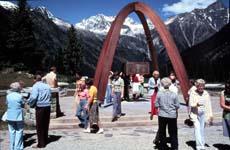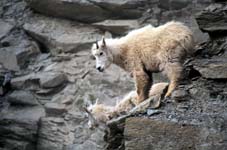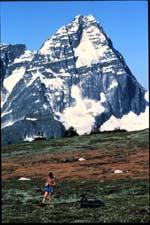Canadian
History Continued
Glacier National Park
B.C.
Glacier National Park was the birthplace of recreational mountaineering in North America, as well as glaciology and mountain photography, and the parks’ first interpretive guide was hired to guide visitors to the Nakimu Caves.

The Valley Of
Hazards - Nakimu Caves
by
Michael Morris, Parks Canada
Nakimu is a native Shuswap word for
“grumbling spirits”, a name inspired by the sound of the throbbing cascades
of Cougar Brook as it disappears from a subalpine forest into a series of sink
holes in Glacier National Park.
Water flowing through a soluble band of
limestone sandwiched between harder rock types has carved an irregular system of
caverns, narrow passages, drop-offs and other strange rock formations
underground. Nakimu Caves, a six kilometre maze of interconnecting passageways,
provides a rare opportunity for exploration into a dark underworld. Visiting the
cave is an inner journey in more ways than one.
First explored by Charles Deutschmann in 1904,
the caves were part of the Glacier House hotel era where early park visitors
were escorted by Deutschmann, working as the first ever interpretive guide hired
by a Canadian national park. A carriage road up Cougar Valley and a teahouse
near the cave entrance were well used through the 1920’s, but visitation
declined with the closure of Glacier House.
The rotten, decrepit remains of staircases
from Deutschmann’s time were removed in recent years by work parties comprised
of local cavers and park staff. Today Nakimu Caves are protected as a wilderness
with the intention of keeping them as natural as possible.
Access to all caves in national parks is
restricted to preserve delicate cave features and to protect unprepared visitors
from a dangerous place. Cavers entering Nakimu must be able to navigate in a
complex system, to crawl through constricted places, and negotiate slippery
surfaces above holes of unknown depths. A permit to enter the caves is limited
to knowledgeable cavers who must apply to the Park Superintendent.
In summer, passages near where the brook
rumbles through reverberate with the sound of crashing water, reminding us that
this cave is still in the process of formation. Blocks of rock still fall from
the ceiling and lower passages can fill with unpredictably with water.
In winter, stream flow is greatly reduced and
most of the seeping water is frozen, often in bizarre arrangements. Cave
temperature is only slightly cooler in winter than in summer, but in contrast to
above ground winter conditions, a winter visitor finds the cave relatively warm.
Moonmilk, a bacteria instigated precipitate of
calcium carbonate, is one of the cave's remarkable features. It coats some of
the cave walls with a pale ooze resembling soft cauliflower. It too easily bears
the imprint of curious hands not intending to leave a permanent record. Marks in
the moonmilk made by visitors from Deutschmann’s time have yet to fully
recover.
|

Moonmilk in the
Nakimu Caves
|
Getting to the cave via Balu Valley is a 7
kilometre journey though avalanche terrain in winter and grizzly habitat in
summer. The use of Cougar Valley for summer access was discontinued in 1996 due
to bears. Subsequent radio-collar results show this area is prime habitat for
female grizzlies. However, this route can be used in winter when it is not
closed for avalanche control. The slopes of Cougar Valley are part of the area
controlled by artillery to protect the Trans-Canada Highway.
Helmets, protective clothing and specialized
caving equipment are required here. Camping is permitted for cavers at Balu
Pass. Caving advice and information regarding snow conditions or bears is
available from Park Wardens. Prior registration for caving is mandatory.
In the cave I marvel at my guide’s ability
to find the route. There are few reference points to indicate which way is up.
For a few moments we extinguish our lights to experience utter blackness. We
cease our prattle and listen to the rumble of the creek in some adjacent
passage.
At the end of our visit we climb out to emerge
from hours spent in dark confines. Back on the surface, I’m a bit dazed by the
intense colours, the complex smells, and the presence of other living things.
The zone on the surface of the planet where life exists seem so
thin.

Glacier National Park
There are seven
roadside picnic areas in Glacier National Park. The glacier-fed rivers and lakes
do not support many game fish.
A fishing ban is
in effect for all streams and rivers in the park. A live bait ban (including
fish eggs) and single hook/lure rule are also in effect for lakes. There are
many trails for hiking through the park but restrictions are in effect for
bicycle use within the park. Bicycles are permitted only on the Trans-Canada
Highway. Biking is not permitted at all on any of the trails throughout Glacier
National Park.
Glacier National Park is accessible by automobile via the
Trans-Canada Highway.
The operational and visitor service centre at the
Rogers Pass Summit is 342 km from Calgary and 643 km to Vancouver. The nearest
communities are Golden, 80 km to the east, and Revelstoke, 72 km to the west,
both of which are serviced by small, chartered aircraft only.|
The City of Revelstoke is located 410 km west of Calgary, 575 km east of
Vancouver.
The only commercial accommodation available in Glacier National Park is the
Glacier Park Lodge in Rogers Pass. The
nearest commercial airports are at Kamloops, Kelowna and Calgary.


Glacier Park (Eastern
View)
Rogers Pass Monument
Travelling from Golden, visitors approach Glacier Park via the
Beaver River Valley. In this northward view, showing the eastern edge of the
park (at left), the lower (1988) CPR railway grades are clearly visible on the
slopes of the Selkirks, as is the Trans-Canada Highway.
Completion of the Trans-Canada Highway in 1962 provided year-round
vehicular access to Glacier national Park for the very first time. This monument
1km west of Rogers Pass Centre was erected to commemorate the opening of the
Trans-Canada Highway.

Mountain Goats
Mountain goats are
often seen along the eastern approaches to Rogers Pass. These yearlings have
descended at Heather Hill to join adults in licking the mineral-rich soil.

Sir Donald Peak
One of the 50
classic climbs of North America, Mt. Sir Donald is a typical "horn",
like Switzerland's Matterhorn. At 3297meters, it is Glacier's fifth highest
peak.

Rogers Pass
Learning Center
The
Rogers Pass Centre features an 80-seat theatre, displays about railway history,
park ecology and recreation, and the Glacier Circle Bookstore. Park staff are
available to answer your questions and assist with your park pass purchases.


Pacific
Express
& Loop
Brook Pillars
Wooden
trestles, snowsheds and stone bridges helped convey the first trains through
Rogers Pass in 1885. Avalanches caused delays and considerable loss of life, so
that by 1916 a tunnel had been constructed to take the trains underground. The
stone pillars along the Loop Brook self-guided trail are among the oldest
man-made structures in Western Canada. They supported a set of trestles that
enabled trains to negotiate the western end of Rogers Pass at an acceptable
grade.

Swiss Guides at Glacier
Park
In
1899, the Canadian Pacific Railway brought two Swiss guides to work at Glacier
House in Rogers Pass. Riding the crest of growing interest in mountaineering in
Europe and the United States, the railway advertised Canada's mountain parks as
50 Switzerlands in one and promoted the role guides played in enjoyable and safe
mountain travel. The guides introduced safe climbing techniques, and helped
establish a sense of appreciation of mountain environments in Canadians. Besides
making mountaineering and exploration history, the Swiss guides also laid the
foundation for the birth of skiing as a winter pastime in the Canadian west. The
spectacular hiking trails radiating from the Illecillewaet campground area were
laid out during the days of Glacier House to provide access to mountaineering
routes. These trails now enjoyed by thousands each year, are the very real
legacy of the Swiss Guides in Glacier National Park.

Glacier Hike
Crossing a glacier on foot requires special skills and equipment. The
Illecillewaet (ILL-ah-SILL-ah-wet) Glacier is one of more than 400 glaciers and
glacierets in the park.

Backpacking through
Glacier Park
The
trail to Copperstain Pass is a multi-day trip that takes hikers into the open,
subalpine reaches of the Bald Hills, seen here against the backdrop of the
massive Selkirk Range.







